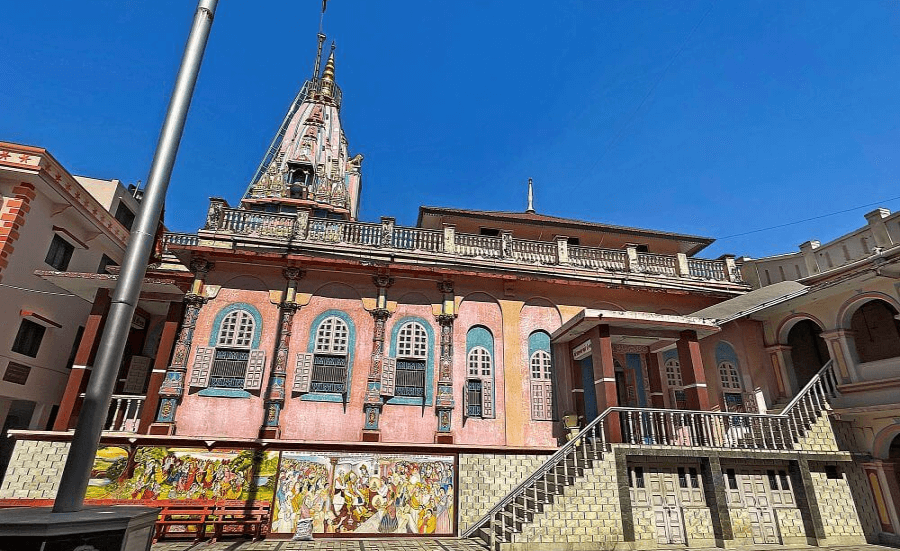
The Ashwinikumar Vaidyaraj Mahadev Temple holds a revered place in the spiritual history of Surat. Associated with the legendary Ashwinikumar brothers, the celestial physicians and sons of the Sun God (Surya Narayan), this temple houses a Shivling established by them. The Tapi Purana mentions this site, and devotees believe the temple to be over 800 years old. The faith surrounding this shrine asserts that Sun God’s eternal presence resides here, and those who bathe in the nearby Tapi River attain salvation, liberating generations of their family. It is also said that even if a servant performs the ancestral rites (Pind Daan) for a childless master here, the latter achieves liberation.
The Ashwinikumar brothers are frequently mentioned in the Rigveda, depicted as guardians of noble deeds, leaders, and healers. They are described as wise, truthful, and destroyers of enemies (Rigveda 1.3.1-3). Legends recount their healing powers: reviving the aging sage Chyavana Rishi (Rigveda 1.68.6), rescuing Bhujyu from drowning in the sea (Rigveda 1.68.7), granting swift horses to King Pedu, and restoring lost kingdoms to Jahusha (Rigveda 1.71.5). Mythologically,
they are believed to be twin sons of Surya (the Sun God) and his consort Sandnya (Saranyu), born in the form of horses, named Nasatya and Dasra, collectively referred to as Ashwinikumar.
According to the 75th chapter of the Tapi Mahatmya, titled “Gupteshwar Prakash Kshetra, Sundarvan Kshetra, Bhaskar Kshetra, Ashwinikumar Kantareshwar Prabhavonnaam”, a fascinating legend is narrated about the origins of the Ashwinikumar Vaidyaraj Mahadev Temple.The Ashwinikumar once visited Indra’s court. Upon seeing their horse-like faces, the sages and attendees present, including Narad Muni, laughed at them. Embarrassed and humiliated, the Ashwinikumars left the court in shame. Later, when Indra inquired with Narad about their lineage, he learned that the brothers were the divine sons of Surya and Sandnya. Realising their significance, Indra extended an invitation, requesting them to return to the court with honour. However, deeply hurt by their humiliation, the Ashwinikumars declined the invitation.
Despondent, the brothers decided to renounce their lives and climbed a mountain to perform penance. Just as they were about to sacrifice themselves, Sage Shringa Mekhala arrived and stopped them. He advised them to instead perform penance near the Tapi River, close to the hermitage of Kapil Muni, and to worship the Sun God. Following the sage’s guidance, the brothers came to the Kantareshwar Teerth near the Tapi River and began their intense austerities. Pleased by their devotion, Surya appeared before them and granted them their wish to be restored to a handsome form. In addition to their transformation, Surya also bestowed upon them profound knowledge of medicine and healing.
Filled with gratitude, the Ashwinikumars established the Shivling of Vaidyaraj Mahadev at this sacred site along the banks of the Tapi River. This Shivling is now revered as a divine symbol of their devotion and their connection to Surya and Shiva.
The temple has undergone multiple renovations over the centuries and now stands as an impressive structure amidst the bustling Varachha neighbourhood. Accessible through a narrow lane, the temple’s entrance features a marble shrine of Lord Shiva, flanked by statues of the Ashwinikumar brothers and Nandi.
The temple’s layout includes a Sabhamandap (assembly hall), Antaral (inner sanctum passage), and Garbhagriha (sanctum sanctorum). The Sabhamandap walls are adorned with intricate sculptures, including Shringi and Bhringi, the dwarpals (guardians) holding tridents and blowing horns, seated Riddhi-Siddhi figures, and a ceiling depicting Lord Shiva with Parvati and young Ganesha seated on a lotus, under the shelter of a five-headed serpent. The marble-carved Nandi in the Sabhamandap is uniquely depicted standing, unlike the seated depictions commonly seen in other temples. Mythological murals from the Ramayana and Mahabharata further enhance the walls. The Antaral’s walls house shrines of Kalabhairav, Surya Narayan, and Shitala Mata, while its dome features painted depictions of serpents and swans.
On the front wall of the sanctum sanctorum, flanking the entrance, a magnificent marble idol of Hanuman is installed on the left, while a similarly grand marble idol of Ganesha is placed on the right. Above these niches, beautiful idols of Shiva and Parvati, as well as Rama and Sita, are positioned. Additionally, above the entrance, a painting of Shiva and Parvati seated alongside Nandi amidst the Himalayan peaks adorns the wall. The entrance to the sanctum sanctorum is square-shaped and notably small, requiring visitors to bow their heads in reverence to enter. At the center of the sanctum, the revered Shivling is enshrined, covered by a serpent hood, symbolising divine protection. It is believed that the Shivling extends 18 feet below the ground, signifying its deep-rooted sanctity. Above the Shivling, a silver canopy (galantika) drips water continuously as part of the abhishek ritual, while a ceremonial umbrella crowns the lingam.
On the rear wall of the sanctum, a beautifully sculpted and ornately adorned idol of Goddess Parvati, wearing a crown and resplendent in her divine attire, adds grace and magnificence to the inner sanctum. This carefully designed sanctum exudes an air of reverence and devotion, attracting devotees who seek the blessings of Shiva and Parvati.
The temple holds daily rituals, with morning prayers at 8:00 AM and evening aarti at 8:00 PM. Major celebrations include Mahashivratri and other Hindu festivals, attracting thousands of devotees. Regular offerings include Rudrabhishek, Maha Puja, and other rituals dedicated to Lord Shiva.
Close to the temple, the Tapi River offers a serene spot for visitors, along with ancient shrines dedicated to Amba Mata and Saraswati Mata. The Dasaram Ashram, established by Saint Batukaram Bapu, provides continuous free meals (annachatra). Adjacent is the Balakrishna Maharaj Samadhi, associated with Swami Samarth’s disciples.



